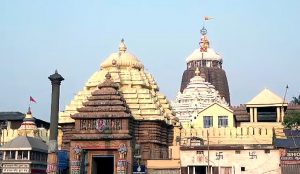Mandira before Srimandira: Decoding enigmatic history of Jagannath Temple Patit Mandal, OP PNN Updated: January 17th, 2024, 06:30 IST in Feature , Home News , Metro 0 File pic Share on Facebook Share on Twitter Share on WhatsApp Share on Linkedin Most of us have studied in our books that Anantavarman Chodaganga Deva of Eastern Ganga dynasty started construction of the Jagannath Temple at Puri in 12th century. Legends, however, speak of a king named Indradyumna who established the Lord’s abode at Puri seashore after sending his astute priest Bidyapati to the kingdom of Sabaras – led by their erstwhile chief Biswabasu. The Indradymna legend, however, cannot be substantiated by historical data and to say that the advent of Gangas led to the construction of Jagannath temple would be ignoring delicate nuances of history.
Also Read Odisha govt urges private establishments to screen Puri Srimandir Parikrama Prakalpa inauguration event 7 hours ago Consecration rituals begin at Ram temple in Ayodhya 11 hours ago Historical evidence and inference suggest existence of a temple in Puri, predating the present-day Srimandira. The temple has an intricate connection with rulers of Somavanshi dynasty that ruled the region before the advent of Gangas. Prominent epigraphist and researcher Dr SN Rajguru, in his book ‘ Sri Purusottama O Srimandira ,’ highlights a unique tradition in ancient Odisha.
Rulers refrained from engraving their names on temple inscriptions – a tradition which has been substantiated by Rajguru based on archaeological findings and literary sources. The Madala Panji narrates the tale of King Indradyumna, the mythical builder of the Jagannath temple, seeking a boon to ensure that no successor would boast about his contribution to the sacred shrine. This restraint extends to the builders of Lingaraj temple and Jagannath temple, where rulers and their descendants abstained from inscribing names on temple walls erected by their dynasty rulers.
Subsequent rulers from different dynasties, however, did mark their contributions on temple walls built by other dynasties. Archaeological evidence suggests that Lingaraj temple — erected by Yayati-II of Somavanshi dynasty in 11th century — lacks inscriptions from Somavanshi era but features those of subsequent Ganga rulers. Lingaraj temple Similarly, the existing Srimandira — initiated by Anantavarman of Ganga dynasty — contains inscriptions from the subsequent Suryavanshi Gajapatis but omits the names of Ganga rulers who governed the region for over three centuries.
Notably, Dr Rajguru’s research speaks of the existence of Purushottam temple in Puri prior to the construction of the present-day Srimandira. Dr Rajguru has written that when the erstwhile Purushottam temple collapsed for some reason, its deities were transferred to a new temple built by Somavanshi ruler Yayati-II (1021–1040). Lord Purushottama was worshipped inside the temple – built in the first half of 11th century.
Meanwhile, present-day Nrusingha temple, positioned southern side of inner enclosure of Srimandira, bears inscriptions from Ganga dynasty, which again proves that the temple predates the Gangas and hints at potential Somavanshi origin given how rulers then avoided using their inscriptions on temples built by them. Again, researcher Jagabandhu Padhi says the architectural style of Nrusingha temple dates as far back as the 10th century which predates Srimandira. Some historians believe present-day Nrusingha temple was the erstwhile Purushottama temple.
Prominent historians say that the initial construction of the existing Jagannath temple was initiated during the lifetime of Chodaganga Deva. It was Anangabhima Deva-III, in 1230, who performed the consecration of Jagannath temple and placed the Holy Trinity inside it. It is mentioned in ancient Hindu scriptures that, primarily the idol of Nrusingha is installed and worshipped before conducting a yajna for any special occasion.
The installed deity is known as ‘Yajna-Nrusingha’. Rajguru believes the Yajna-Nrusingha that was worshipped for the consecration yajna of Srimandira in 13th century was later placed inside the Purushottama temple, which led to the name change. Hence, the 11th-century Purushottama temple raised by Yayati-II came to be known as Nrusingha temple in 13th century.
Madala Panji (Jagannath temple chronicle) reveals the endeavours of Somavanshi ruler ‘Yayati Keshari’, who erected a temple for Lord Jagannath. It is noted that 146 years before Yayati’s reign, a yavana called ‘Raktavahu’ invaded Purushottma Kshetra, prompting priests to move the images to Gopali village in Subarnapur. In his 11th year as ruler, Yayati discovered this and, after retrieving the ‘Brahma’ and after creating new idols, consecrated and placed them in his newly constructed temple.
In a nutshell, it can be mentioned that Madala Panji’s Yayati Keshari has been corroborated by historical figure Yayati-II. This evidence also points to existence of a temple that predates the Srimandira which could have led to the origin of Jagannath cult in the state. By Patit Mandal, OP Tags: jagannath temple Madala Panji Nrusingha temple Puri Srimandira Share Tweet Send Share Suggest A Correction Enter your email to get our daily news in your inbox.
Leave this field empty if you’re human:.
From: orissapost
URL: https://www.orissapost.com/mandira-before-srimandira-decoding-enigmatic-history-of-jagannath-temple/



